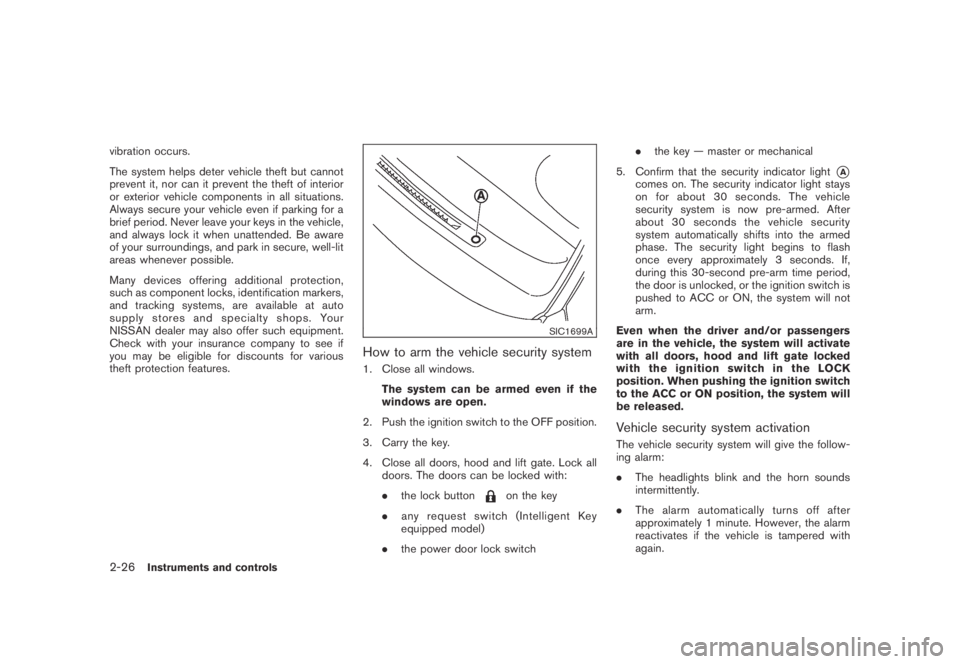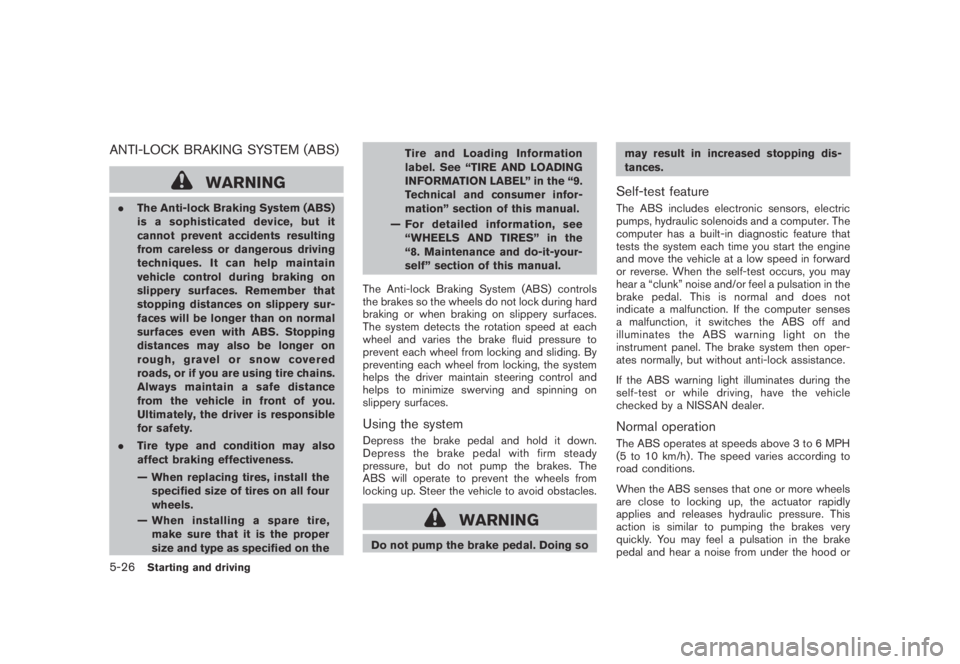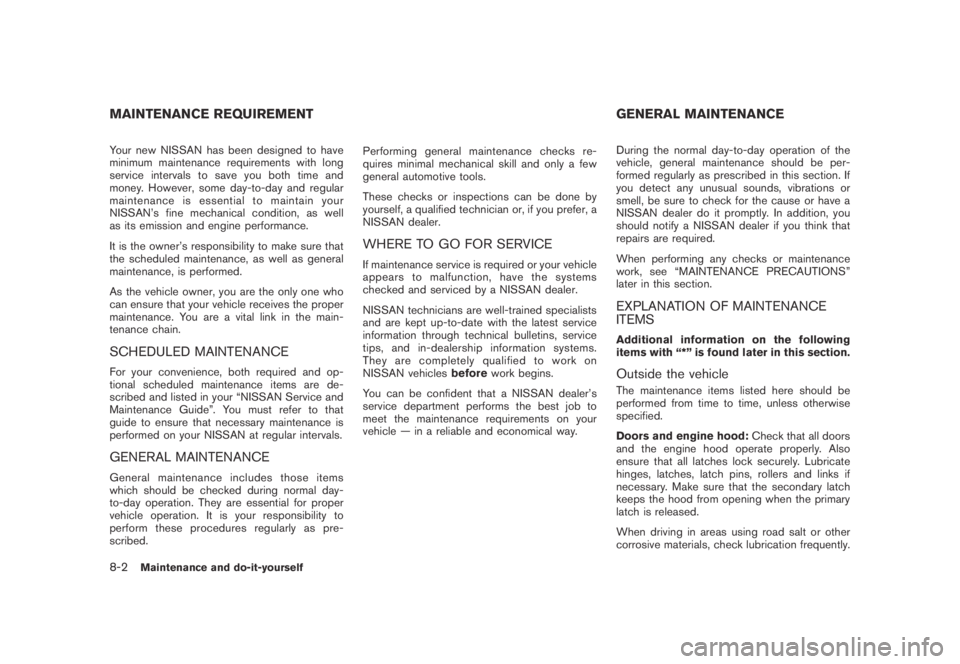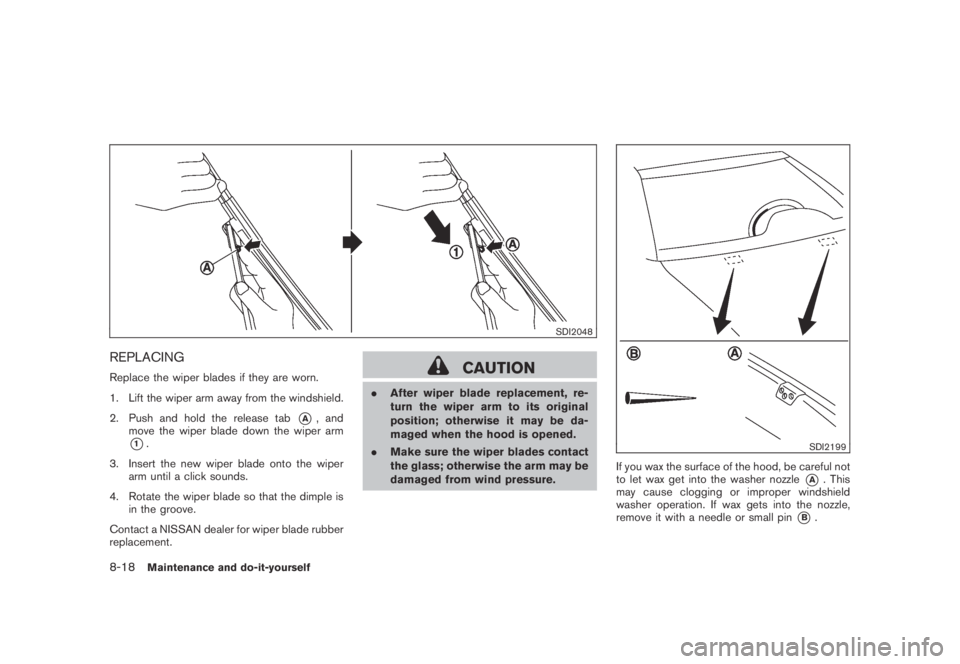2009 NISSAN MURANO hood release
[x] Cancel search: hood releasePage 96 of 443

Black plate (94,1)
Model "Z51-D" EDITED: 2007/ 10/ 2
vibration occurs.
The system helps deter vehicle theft but cannot
prevent it, nor can it prevent the theft of interior
or exterior vehicle components in all situations.
Always secure your vehicle even if parking for a
brief period. Never leave your keys in the vehicle,
and always lock it when unattended. Be aware
of your surroundings, and park in secure, well-lit
areas whenever possible.
Many devices offering additional protection,
such as component locks, identification markers,
and tracking systems, are available at auto
supply stores and specialty shops. Your
NISSAN dealer may also offer such equipment.
Check with your insurance company to see if
you may be eligible for discounts for various
theft protection features.
SIC1699A
How to arm the vehicle security system
1. Close all windows.
The system can be armed even if the
windows are open.
2. Push the ignition switch to the OFF position.
3. Carry the key.
4. Close all doors, hood and lift gate. Lock all
doors. The doors can be locked with:
.the lock button
on the key
.any request switch (Intelligent Key
equipped model)
.the power door lock switch.the key — master or mechanical
5. Confirm that the security indicator light
*Acomes on. The security indicator light stays
on for about 30 seconds. The vehicle
security system is now pre-armed. After
about 30 seconds the vehicle security
system automatically shifts into the armed
phase. The security light begins to flash
once every approximately 3 seconds. If,
during this 30-second pre-arm time period,
the door is unlocked, or the ignition switch is
pushed to ACC or ON, the system will not
arm.
Even when the driver and/or passengers
are in the vehicle, the system will activate
with all doors, hood and lift gate locked
withtheignitionswitchintheLOCK
position. When pushing the ignition switch
to the ACC or ON position, the system will
be released.
Vehicle security system activation
The vehicle security system will give the follow-
ing alarm:
.The headlights blink and the horn sounds
intermittently.
.The alarm automatically turns off after
approximately 1 minute. However, the alarm
reactivates if the vehicle is tampered with
again.
2-26Instruments and controls
Page 131 of 443

Black plate (10,1)
3 Pre-driving checks and adjustments
Model "Z51-D" EDITED: 2007/ 10/ 2
Keys ............................................................... 3-2
NISSAN Vehicle Immobilizer System keys............ 3-2
Intelligent Key system (if so equipped)................ 3-3
Mechanical key.............................................. 3-4
Valet hand-off................................................ 3-4
Doors.............................................................. 3-4
Locking with mechanical key............................. 3-5
Opening and closing windows with the
mechanical key.............................................. 3-5
Locking with inside lock knob........................... 3-5
Locking with power door lock switch.................. 3-6
Vehicle speed sensing door lock mechanism........ 3-6
Automatic door unlock mechanism..................... 3-6
Child safety rear door lock............................... 3-7
Intelligent Key system (if so equipped).................... 3-7
Intelligent Key operating range.......................... 3-8
Door locks/unlocks precaution.......................... 3-9
Intelligent Key operation.................................3-10
Battery saver system.....................................3-13
Warning signals...........................................3-13
Troubleshooting guide...................................3-14
Remote keyless entry system..............................3-15
How to use remote keyless entry system...........3-15Hood............................................................3-18
Lift gate.........................................................3-18
Operating manual lift gate..............................3-19
Operating power lift gate (if so equipped)..........3-19
Auto closure...............................................3-22
Lift gate release...........................................3-23
Fuel-filler door.................................................3-23
Opening fuel-filler door..................................3-23
Fuel-filler cap..............................................3-23
Tilting telescopic steering column........................3-25
Manual operation.........................................3-25
Electric operation.........................................3-25
Sun visors......................................................3-26
Mirrors...........................................................3-27
Inside mirror................................................3-27
Outside mirrors............................................3-28
Vanity mirror................................................3-29
Automatic drive positioner (if so equipped).............3-30
Entry/exit function.........................................3-30
Memory storage...........................................3-30
System operation.........................................3-31
Page 148 of 443

Black plate (148,1)
Model "Z51-D" EDITED: 2007/ 10/ 2
SPA2437
1. Pull the hood lock release handle*1located below the instrument panel; the
hood will then spring up slightly.
2. Pull the lever
*2up at the front of the hood
with your fingertips and raise the hood.
3. When closing the hood, slowly close the
hood down and make sure it locks into
place.
WARNING
.Make sure the hood is completely
closed and latched before driving.
Failure to do so could cause the
hood to fly open and result in an
accident.
.If you see steam or smoke coming
from the engine compartment, to
avoid injury do not open the hood.
WARNING
.Always be sure the lift gate has
been closed securely to prevent it
from opening while driving.
.Do not drive with the lift gate open.
This could allow dangerous exhaust
gases to be drawn into the vehicle.
See “EXHAUST GAS (carbon mon-
oxide)” in the “5. Starting and driv-
ing” section of this manual.
.Do not leave children unattended
inside the vehicle. They could un-
knowingly activate switches or con-
trols. Unattended children could
become involved in serious acci-
dents.
.Always be sure that hands and feet
are clear of the door frame to avoid
injury while closing the lift gate.
HOODLIFT GATE
3-18Pre-driving checks and adjustments
Page 338 of 443

Black plate (338,1)
Model "Z51-D" EDITED: 2007/ 10/ 2
ANTI-LOCK BRAKING SYSTEM (ABS)
WARNING
.The Anti-lock Braking System (ABS)
is a sophisticated device, but it
cannot prevent accidents resulting
from careless or dangerous driving
techniques. It can help maintain
vehicle control during braking on
slippery surfaces. Remember that
stopping distances on slippery sur-
faces will be longer than on normal
surfaces even with ABS. Stopping
distances may also be longer on
rough, gravel or snow covered
roads, or if you are using tire chains.
Alwaysmaintainasafedistance
from the vehicle in front of you.
Ultimately, the driver is responsible
for safety.
.Tire type and condition may also
affect braking effectiveness.
— When replacing tires, install the
specified size of tires on all four
wheels.
— When installing a spare tire,
make sure that it is the proper
size and type as specified on theTire and Loading Information
label. See “TIRE AND LOADING
INFORMATION LABEL” in the “9.
Technical and consumer infor-
mation” section of this manual.
— For detailed information, see
“WHEELS AND TIRES” in the
“8. Maintenance and do-it-your-
self” section of this manual.
The Anti-lock Braking System (ABS) controls
the brakes so the wheels do not lock during hard
braking or when braking on slippery surfaces.
The system detects the rotation speed at each
wheel and varies the brake fluid pressure to
prevent each wheel from locking and sliding. By
preventing each wheel from locking, the system
helps the driver maintain steering control and
helps to minimize swerving and spinning on
slippery surfaces.
Using the system
Depress the brake pedal and hold it down.
Depress the brake pedal with firm steady
pressure, but do not pump the brakes. The
ABS will operate to prevent the wheels from
locking up. Steer the vehicle to avoid obstacles.
WARNING
Do not pump the brake pedal. Doing somay result in increased stopping dis-
tances.
Self-test feature
The ABS includes electronic sensors, electric
pumps, hydraulic solenoids and a computer. The
computer has a built-in diagnostic feature that
tests the system each time you start the engine
and move the vehicle at a low speed in forward
or reverse. When the self-test occurs, you may
hear a “clunk” noise and/or feel a pulsation in the
brake pedal. This is normal and does not
indicate a malfunction. If the computer senses
a malfunction, it switches the ABS off and
illuminates the ABS warning light on the
instrument panel. The brake system then oper-
ates normally, but without anti-lock assistance.
If the ABS warning light illuminates during the
self-test or while driving, have the vehicle
checked by a NISSAN dealer.
Normal operation
The ABS operates at speeds above 3 to 6 MPH
(5 to 10 km/h) . The speed varies according to
road conditions.
When the ABS senses that one or more wheels
are close to locking up, the actuator rapidly
applies and releases hydraulic pressure. This
action is similar to pumping the brakes very
quickly. You may feel a pulsation in the brake
pedal and hear a noise from under the hood or
5-26Starting and driving
Page 366 of 443

Black plate (368,1)
Model "Z51-D" EDITED: 2007/ 10/ 2
Your new NISSAN has been designed to have
minimum maintenance requirements with long
service intervals to save you both time and
money. However, some day-to-day and regular
maintenance is essential to maintain your
NISSAN’s fine mechanical condition, as well
as its emission and engine performance.
It is the owner’s responsibility to make sure that
the scheduled maintenance, as well as general
maintenance, is performed.
As the vehicle owner, you are the only one who
can ensure that your vehicle receives the proper
maintenance. You are a vital link in the main-
tenance chain.
SCHEDULED MAINTENANCE
For your convenience, both required and op-
tional scheduled maintenance items are de-
scribed and listed in your “NISSAN Service and
Maintenance Guide”. You must refer to that
guide to ensure that necessary maintenance is
performed on your NISSAN at regular intervals.
GENERAL MAINTENANCE
General maintenance includes those items
which should be checked during normal day-
to-day operation. They are essential for proper
vehicle operation. It is your responsibility to
perform these procedures regularly as pre-
scribed.Performing general maintenance checks re-
quires minimal mechanical skill and only a few
general automotive tools.
These checks or inspections can be done by
yourself, a qualified technician or, if you prefer, a
NISSAN dealer.
WHERE TO GO FOR SERVICE
If maintenance service is required or your vehicle
appears to malfunction, have the systems
checked and serviced by a NISSAN dealer.
NISSAN technicians are well-trained specialists
and are kept up-to-date with the latest service
information through technical bulletins, service
tips, and in-dealership information systems.
They are completely qualified to work on
NISSAN vehiclesbeforework begins.
You can be confident that a NISSAN dealer’s
service department performs the best job to
meet the maintenance requirements on your
vehicle — in a reliable and economical way.During the normal day-to-day operation of the
vehicle, general maintenance should be per-
formed regularly as prescribed in this section. If
you detect any unusual sounds, vibrations or
smell, be sure to check for the cause or have a
NISSAN dealer do it promptly. In addition, you
should notify a NISSAN dealer if you think that
repairs are required.
When performing any checks or maintenance
work, see “MAINTENANCE PRECAUTIONS”
later in this section.
EXPLANATION OF MAINTENANCE
ITEMS
Additional information on the following
items with “*” is found later in this section.
Outside the vehicle
The maintenance items listed here should be
performed from time to time, unless otherwise
specified.
Doors and engine hood:Check that all doors
and the engine hood operate properly. Also
ensure that all latches lock securely. Lubricate
hinges, latches, latch pins, rollers and links if
necessary. Make sure that the secondary latch
keeps the hood from opening when the primary
latch is released.
When driving in areas using road salt or other
corrosive materials, check lubrication frequently.
MAINTENANCE REQUIREMENT GENERAL MAINTENANCE
8-2Maintenance and do-it-yourself
Page 382 of 443

Black plate (384,1)
Model "Z51-D" EDITED: 2007/ 10/ 2
SDI2048
REPLACING
Replace the wiper blades if they are worn.
1. Lift the wiper arm away from the windshield.
2. Push and hold the release tab
*A, and
move the wiper blade down the wiper arm
*1.
3. Insert the new wiper blade onto the wiper
arm until a click sounds.
4. Rotate the wiper blade so that the dimple is
in the groove.
Contact a NISSAN dealer for wiper blade rubber
replacement.
CAUTION
.After wiper blade replacement, re-
turn the wiper arm to its original
position; otherwise it may be da-
maged when the hood is opened.
.Make sure the wiper blades contact
the glass; otherwise the arm may be
damaged from wind pressure.
SDI2199
If you wax the surface of the hood, be careful not
to let wax get into the washer nozzle
*A. This
may cause clogging or improper windshield
washer operation. If wax gets into the nozzle,
remove it with a needle or small pin
*B.
8-18Maintenance and do-it-yourself
Page 436 of 443

Black plate (3,1)
FM-AM-SAT radio with Compact Disc (CD)
changer............................................. 4-44
Fog light switch.................................... 2-36
Front manual seat adjustment....................... 1-3
Front passenger air bag and status light........ 1-48
Front power seat adjustment....................... 1-4
Front seat adjustment ............................... 1-3
Front-seat active head restraints................... 1-9
Fuel
Capacities and recommended
fuel/lubricants.................................... 9-2
Distance to empty............................. 2-23
Fuel economy.................................. 5-20
Fuel economy information (display)............. 4-9
Fuel octane rating................................ 9-3
Fuel recommendation............................ 9-3
Fuel-filler cap................................... 3-23
Fuel-filler door.................................. 3-23
Gauge ............................................ 2-7
Fuses ............................................... 8-20
Fusible links........................................ 8-20
G
Garage door opener, HomeLink
®Universal
Transceiver......................................... 2-57
Gas cap ............................................ 3-23
Gauge ................................................ 2-4
Engine coolant temperature gauge............. 2-6
Fuel gauge....................................... 2-7
Odometer......................................... 2-5
Speedometer..................................... 2-5
Tachometer....................................... 2-6
Trip computer .................................. 2-21
General maintenance................................ 8-2Glove box........................................... 2-43
H
Hands-free phone system, Bluetooth
®
(with navigation system for Canada)............. 4-85
Hands-free phone system, Bluetooth®
(with navigation system for U.S.)................. 4-75
Hazard warning flasher switch.................... 2-36
Head restraints....................................... 1-8
Headlights
Aiming control.................................. 2-34
Bulb replacement.............................. 8-25
Headlight switch ............................... 2-32
Xenon headlights .............................. 2-32
Headphones (See NISSAN mobile
entertainment system)...................... 4-65, 4-72
Heated seats....................................... 2-37
Heater
Engine block heater........................... 5-29
Heater and air conditioner operation......... 4-26
HomeLink
®Universal Transceiver................. 2-57
Hood release....................................... 3-18
Hook
Coat hooks..................................... 2-49
Luggage hook.................................. 2-47
Horn ................................................ 2-37
I
Ignition switch (Push-button)....................... 5-8
Immobilizer system................................. 2-27
In-cabin microfilter................................. 4-30
Indicator lights..................................... 2-15
Indicator, Dot matrix display....................... 2-17
INFO button.......................................... 4-8Inside mirror........................................ 3-27
Inspection/maintenance (I/M) test................ 9-25
Instrument brightness control..................... 2-35
Instrument panel..................................... 2-2
Intelligent Key system......................... 3-3, 3-7
Key operating range............................. 3-8
Key operation.................................. 3-10
Warning light................................... 2-12
Warning signals................................ 3-13
Intelligent Key warning light....................... 2-12
Interior light control switch........................ 2-54
Interior light replacement.......................... 8-27
Interior lights....................................... 2-54
iPod
®player operation............................. 4-51
ISOFIX child restraint.............................. 1-23
J
Jump starting......................................... 6-9
K
Keyless entry (See remote keyless entry
system)............................................. 3-15
Keys................................................... 3-2
Keys, For Intelligent Key system.............. 3-3, 3-7
L
Labels
Air bag warning labels......................... 1-54
Air conditioner specification label............ 9-10
Emission control information label............ 9-10
Engine serial number ............................ 9-9
F.M.V.S.S./C.M.V.S.S. certification label........ 9-9
Tire and Loading Information label.... 8-31, 9-10
10-3
Model "Z51-D" EDITED: 2007/ 10/ 2
Page 443 of 443

Black plate (3,1)
Model "Z51-D" EDITED: 2007/ 10/ 2
STI0565
1. Battery (P.8-13)
2. Brake fluid (P.8-12)
3. Supplemental front-impact air bags (P.1-41)
4. Meters and gauges (P.2-4)
5. Hood release (P.3-18)
6. Seat (P.1-2)
7. Seat belt (P.1-10)
8. Door lock (P.3-4)
9. Fuel-filler door (P.3-23)
Fuel recommendation (P.9-3)
10. Engine oil (P.8-8)
11. Engine coolant (P.8-7)
12. Window washer fluid (P.8-12)
13. Air conditioner (P.4-26)
Audio system (P.4-31)
14. Spare tire (P.6-2)
QUICK REFERENCE